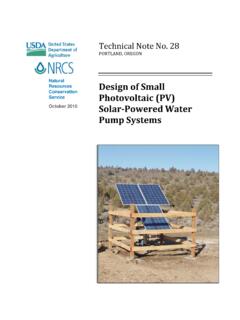Transcription of Electric Vehicle Life Cycle Cost Analysis
1 Electric Vehicle Life Cycle Cost Analysis Richard Raustad Electric Vehicle Transportation Center Florida solar Energy Center 1679 Clearlake Road Cocoa, FL 32922-5703. Submitted as: Final Research Project Report EVTC Project 6 Electric Vehicle Life Cycle Cost Analysis Submitted to: Ms. Denise Dunn Research and Innovative Technology Administration 1200 New Jersey Avenue, SE. Washington, DC 20590. E-mail: Contract Number: DTRT13-G-UTC51. EVTC Report Number: FSEC-CR-2053-17. February 2017. The contents of this report reflect the views of the authors, who are responsible for the facts and the accuracy of the information presented herein.
2 This document is disseminated under the sponsorship of the Department of Transportation's University Transportation Centers Program in the interest of information exchange. The Government assumes no liability for the contents or use thereof. 1. Acknowledgements This report is a final research report for the Electric Vehicle Life Cycle Cost Analysis project of the Electric Vehicle Transportation Center (EVTC) at the University of Central Florida (UCF). The Electric Vehicle Transportation Center is a University Transportation Center funded by the Research and Innovative Technology Administration of the Department of Transportation.
3 The EVTC is a research and education center whose projects prepare the transportation system for the influx of Electric vehicles into a sustainable transportation network and investigate the opportunity these vehicles present to enhance Electric grid modernization efforts. The EVTC is led by UCF's Florida solar Energy Center partners from UCF's Departments of Electrical Engineering and Computer Science and Civil, Environmental and Construction Engineering, the University of Hawaii, and Tuskegee University. The objective of the Electric Vehicle Life Cycle Cost Analysis project was to compare total life Cycle costs of Electric vehicles, plug-in hybrid Electric vehicles, hybrid Electric vehicles, and compare with internal combustion engine vehicles.
4 The Analysis has considered both capital and operating costs in order to present an accurate assessment of lifetime ownership costs. The Analysis also included Vehicle charging scenarios of photovoltaic ( solar Electric ) powered charging and workplace charging. The work was conducted by Richard Raustad, Principle Investigator, and Philip Fairey of the Florida solar Energy Center. 2. Final Research Project Report Electric Vehicle Life Cycle Cost Analysis Richard Raustad Electric Vehicle Transportation Center January 2017. Abstract This project compared total life Cycle costs of battery Electric vehicles (BEV), plug-in hybrid Electric vehicles (PHEV), hybrid Electric vehicles (HEV), and vehicles with internal combustion engines (ICE).
5 The Analysis considered capital and operating costs in order to present an equal comparison of differing vehicles. The Analysis also included photovoltaic (PV) and workplace charging options. The overall goal was to define the total Vehicle cost of ownership over 5, 10, 15, and 20 year life expectancies. The developed life Cycle cost computer program will allow any individual to compare life Cycle costs of any Vehicle . Research Results This project had three objectives as follows: 1. To develop a life Cycle cost (LCC) model for automotive vehicles that accurately evaluates Electric Vehicle types, 2.
6 To allow for any user to download and use the developed LCC model, and 3. To evaluate photovoltaics (PV) as a power option for Electric vehicles. The details of the developed LCC model and it applications were presented in an EVTC technical report -- Raustad, R., Fairey, P. (2014). Electric Vehicle Life Cycle Costs Assessment. Electric Vehicle Transportation Center, FSEC-CR-1984-14. For completeness of this document the EVTC report is presented in Appendix 1. The developed LCC model will compare ownership costs, on a present value and an annual cost basis, of plug- in hybrid Electric vehicles (PHEV) and battery Electric vehicles (BEV) as compared to conventional internal combustion engine (ICE) vehicles for an average number of miles driven per year.
7 The Analysis used actual 2014 cost values for 16 production vehicles all sold in the United States. The LCC model includes the Vehicle costs of purchase price with federal incentives, if any, salvage value, fuel consumption (electricity and liquid fuel), tires, insurance, maintenance, state tax and financed interest payments. The vehicles considered are hybrid Electric vehicles, PHEVs, and BEVs as compared to ICEs using gasoline, ethanol, or diesel. It is noted that the traction battery replacement costs for Electric vehicles were difficult to ascertain, but were included in the Analysis by replacing the batteries in the 11th year in order to investigate the battery impact on overall costs.
8 Economic factors used in the LCC include differing rates for inflation, discount, and fuel escalation and battery degradation in the Electric vehicles to account for battery energy depletion over time. The LCC was performed over a 5-, 10-, or 15-year lifetime period. Results were presented for the specific case of 12,330 miles driven per year and for the selected economic factors. These LCC results show that even with higher first costs, battery powered vehicles are lower in cost to conventional ICE vehicles. Using the two lowest-cost variant vehicles, a Nissan Leaf and a Hyundai Elantra, the Leaf's 5-year annual cost including salvage value is $5,360/year compared to the Hyundai at $7,076/year.
9 The 3. results for the 10-year lifetime show the Leaf at $4,683/year and the Hyundai at $6,040/year. These results are primarily due to lower fuel cost of electricity versus gasoline, which for the Leaf is $3,919 while the Hyundai gasoline cost is $10,931 for the 10-year period. A comparison of two other popular plug-in Electric vehicles, the Chevrolet Volt and Toyota Prius, shows higher values for both vehicles; over a period of 10 years, the Volt is $6,286/year and the Prius is $6,156/year. The results for the case where the government incentive of $7,500 is deleted also show the LCC values for a Leaf over a 10-year period is less than the Hyundai when salvage value is considered.
10 The Leaf is $5,369/year compared to the Hyundai at $6,040/year. For a 5-year period, this result is also true where the Leaf is $6,733/year and the Hyundai is $7,076/year. The results for the case where the vehicles are owned for 5 years are shown in the below Figure 1. These results show the lowest cost option is the Chev Spark followed by the Nissan Leaf. Figure 1. 5-Year Financed Ownership Cost Impacts/Benefits The results provide consumers with the requisite information needed to make an informed financial decision regarding the purchase of personal transportation using LCC cost comparisons.









